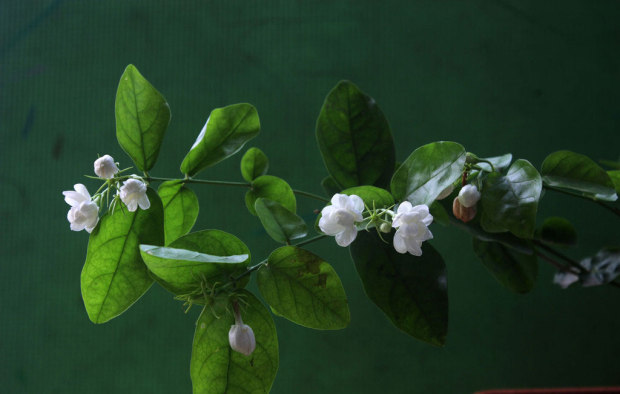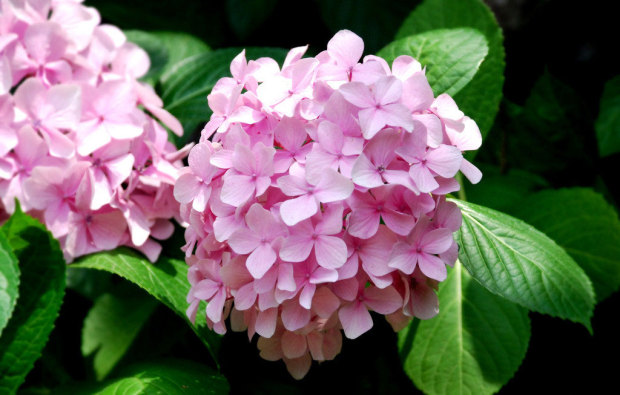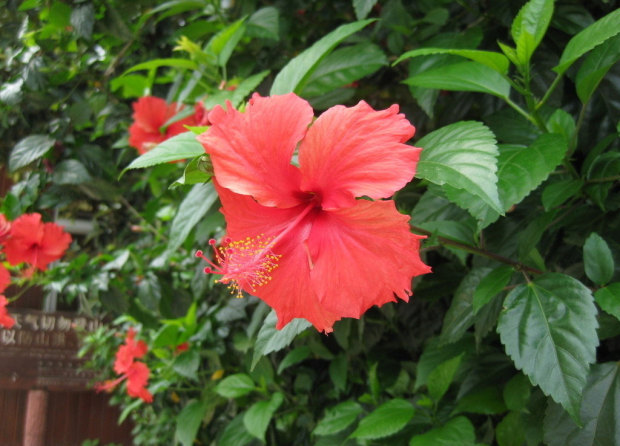Cultivation and culture methods of jasmine
"what a jasmine flower, what a jasmine flower, the flower blossoms all over the garden, but the fragrance doesn't smell like it." These are the lyrics from the Jiangnan folk song "Riley Flower", which is very familiar to everyone. This shows the position of jasmine in people's life. People love jasmine and sing about jasmine, of course, not only because its flower aroma is pure and elegant, fragrant and pleasant, it is a good product for women to decorate, but also it has very far economic value. Its flowers can be used to smoke scented tea, extract essence, and sell well at home and abroad. For a long time, there have been many flower growers growing jasmine for a living in the suburbs of Guangdong, Fujian, Anhui, Suzhou, Hangzhou and other southern provinces. Jasmine is closely related to people's economic and cultural life. Jasmine is also one of the best varieties of flowers in the family. In summer, a pot of jasmine is placed in the courtyard. In the evening, the breeze is accompanied by the fragrance of jasmine flowers. It will make people enjoy the cool forget their fatigue and feel refreshed. So, of course, it's not surprising that people love jasmine.

Native to India and Iran, jasmine was introduced into China during the Han Dynasty more than 1700 years ago. It likes the sunny, hot and humid climate, and is afraid of cold. Although slight frost can cause leaves to fall off, it grows best at 2535 degrees. The fragrance of the flowers is the strongest when it is warm, humid and sunny in summer. Jasmine likes fertilizer, and in cultivation, slightly acidic sandy loam is the most suitable for it. Jasmine is not resistant to drought but is also afraid of waterlogging, so potted Rongli should remove stagnant water from the basin in time when it is rainy in summer. Cultivation and maintenance of jasmine jasmine, also known as Mali, tea flower, is a perennial evergreen shrub of the jasmine genus of Oleaceae. Native to India and other countries, there are cultivation in the north and south of our country. The jasmine plant is exquisite and beautiful, the leaves are emerald and green, the flowers are white and fragrant, and it is known as the first fragrance of fragrant flowers. Its fragrance is clear but not light, strong but not strong, the flowering period is long, and it blooms most in summer. A pot of fragrance floats all over the room on the courtyard windowsill and balcony, which is the most common fragrant potted flowers and trees.
First, biological characteristics of jasmine flowers like warm, humid and sunny environment, afraid of freezing, drought and waterlogging, daily average temperature is more than 19 ℃ to sprout, more than 25 ℃ to give birth to buds, about 15 days from bud formation to flowering, 32-35 ℃ is the most suitable for buds to mature and open, more than 37 ℃, fragrance weakens, flowers will produce muggy yellow phenomenon,-3 ℃ or so, aboveground branches are in danger of freezing. Like fertile, loose and well-drained slightly acidic sandy loam, avoid alkaline soil and clayey soil. The phenomenon of poor growth in too shady places, such as sparse leaves, light leaves, thin branches, few flowers and so on. Second, the culture method of jasmine is commonly used in three methods: cuttage, ramet and striping. The main results are as follows: 1. Cutting culture is the most commonly used culture method of jasmine. The mixed substrate of sand or sand and mud can be used from April to October, and the plum rain season is the most suitable, so the time is warm and humid. Select mature and strong one-year-old branches, about 10 cm long with 3 or 4 nodes, leave a pair of complete leaves at the top, and remove the rest. First, the hole was inserted with a bamboo stick, and the depth of the cuttings was 2. 3, then watered, moisturized and shaded to maintain high air humidity, new roots grew in about 20 days, branches and leaves came out after 50 days, and could be transplanted after 2 months. Jasmine can also be inserted with water and take root in 10 to 15 days, which is suitable for families to plant in small quantities. It can be from April to October, and the optimum period is before the spring temperature rises and the branches sprout. You can choose strong biennial branches with full bud eyes, about 15 cm long with 4-6 axillary buds and 2-3 leaves at the top. Choose glass parallel or other containers, opaque is the best, conducive to root. Fill the bottle with cold boiled water, wash the cuttings and insert them into the bottle. Soak the cuttings in water about 2GP3. The mouth of the bottle is stuck with skimmed cotton, so that the cuttings are suspended in the bottle without touching the bottom of the bottle. In the back shade, keep the temperature above 20 ℃, avoid direct sunlight, and change cold boiled water once every 2-3 days. It can take root under the festival after 10-15 days. 2. Striping culture of jasmine flowers is mostly carried out in the growing period, taking the branches near the ground as strips, peeling or scratching where they need to take root, then pressing them into the soil and fixing them, compacting the soil, exposing the soil surface at the top of the branches and moisturizing. After 5 months, the mother plant can be cut off and planted separately. 3. The regeneration ability of ramet jasmine is strong, and adventitious buds often occur in the roots, forming new branches, which can be used for ramet culture, which is usually carried out in combination with transplanting and changing pots in spring or autumn. Select the plant with many prosperous branches, pull up the whole plant and split it with a sharp knife, and use the small plant with roots for planting. Generally speaking, you can only separate 2-3 plants from the mother plant at a time, or dig up the soil around the mother plant and cut off the sub-plant. Ramet culture requires that the amount of roots should be commensurate with the plant, too many branches and leaves should be trimmed part of the branches and leaves to ensure survival, shade and heat preservation after planting. Cultivation management 1. The cultivation medium is loose and fertile weakly acidic sandy loam soil with rich organic matter and good aggregate structure, which can be mixed with sun-dried pond mud, humus soil, rotten organic fertilizer and appropriate amount of river sand. 2. Fertilizer and water management jasmine flowers like fertilizer, heavy application of organic fertilizer as base fertilizer, topdressing compound fertilizer during the growing period, less application of young trees and more application of strong trees, first loosen the soil and then apply fertilizer. Topdressing fertilizer is applied between the plant and the plant, and do not pour it on the plant. At the early stage of pregnancy, urea, potassium dihydrogen phosphate or calcium superphosphate were used as extra-root topdressing to promote the development of flower buds. Jasmine likes weak and acidic soil, alum fertilizer and water can be used as topdressing at ordinary times, and a small amount of available phosphate fertilizer can be applied during flowering to thicken the flower fragrance. After flowering, it is necessary to apply fertilizer and sufficient fertilizer in time to promote the development and rapid growth of new branches, because jasmine blossoms in buds on new branches, laying a good foundation for the next flowering. From June to August, jasmine blossoms should be fertilized more frequently, combined with watering once a week, and the temperature gradually decreases after autumn. Fertilization should be stopped to prevent the influence of new shoots on overwintering, and sufficient fertilizer should be applied before sprouting in spring to promote the emergence of sturdy new shoots. Jasmine flowers like a humid environment, too dry will shed leaves, too wet will rot roots, generally spring sunny days once every 2 to 3 days, summer is the peak period of pregnant buds blossom, high temperature and transpiration, should be irrigated once a day in the morning and evening, summer days often spray water to make the leaves wet overnight, once a day in autumn, during the period from the Winter Solstice to the Beginning of Spring, water should be watered once before moving indoors for winter, usually less watering, basin soil should be watered again after dry Warm areas can be outdoors overwintering, well water or heating water should be used for watering in winter, and overcooled water is avoided. When the bud is just formed, it should be watered once, that is, it will not be watered in the morning, and then watered when the bud "bows its head" in the evening, which can promote the flower to be stout and bloom neatly. 3. Plastic pruning jasmine has strong germination, and regular pruning can promote it to grow new shoots and blossom more. Pruning and shaping was carried out in combination with changing pots before sprouting in spring, thin and weak branches were thinned, disease and insect branches and withered branches were removed, and short one-year-old branches left only the base of stout branches with 4 nodes in each branch. Another situation is pruning in the growing period, the purpose is to improve ventilation and light transmission conditions, to promote neat and sturdy new branches, generally cut off non-flowering branches, only long branches, disease and insect branches, thin and weak branches, over-dense branches and so on. The young jasmine topped to promote the branching to form a good tree shape; the middle-aged jasmine plants should retain the germinated shoots in early autumn and cut off the germinated new shoots in late autumn; the old jasmine plants should retain the new shoots germinated in summer and cut off the new shoots germinated in autumn to prolong their life; aging jasmine plants are rejuvenated and restored to exuberant vitality by "one-size-fits-all" re-pruning and rejuvenation, which is usually carried out from early March to early April. 4. After the beginning of spring, the jasmine flower produces new shoots for the first time, followed by the first flower buds, but at this time the temperature is still low or unstable, the temperature difference between day and night is large, which is not conducive to the development of flower buds, small fragrance and less fragrance, in order to reduce nutrient consumption, the buds produced for the first time are often removed to promote more new shoots and give birth to more and better buds. Pot cultivation method of jasmine cultivation method of family culture of jasmine
There are always some colors to fill in. Big or small, a rain, at the top of the earth. After April, it will be the sound of the waves. The wind rattled into my ears, and so quickly, the sun walked around the tree and brought in a group of leaves. And birdsong. Birds chirping in the warm breeze, streets reflected above the streets, songs sung in songs. Above the earth. A kind of listening, seize the sun and the wind, seize the power of the years. So, do you know anything about jasmine? Next, the editor will introduce jasmine to you.
(1) selecting basin
According to the characteristics of the root system of jasmine, which requires good permeability and humid environment, potted jasmine should be planted in plain mud basin, glaze basin, porcelain basin and so on. There are generally three specifications of plain burning mud basin suitable for planting jasmine: caliber 25cm with a height of 15cm, caliber 30cm with a height of 17cm, and caliber 36cm with a high 22cm. The diameter of the flowerpot is slightly smaller than that of the tree crown, which is beneficial to maintain the humidity of the pot soil.
(2) preparation of cultivated soil
It was made of 4 parts of loam, 4 parts of compost and 2 parts of sand, plus a small amount of bone powder, cake fertilizer, plant ash and so on. It is required that the cultivated soil is fertile, loose, strong in water and fertility conservation and good in permeability. Rotten garbage can be sifted through 16 holes instead of sand and disinfected with formalin. Sprinkle 1.5% formalin 2L evenly in lOOm3 soil, then cover it with grass or mat and use it after 48 hours.
(3) upper basin
First cover the drain with tiles or broken pots, add 3cm thick coarse culture soil or coarse sand or cinder, and then plant with the prepared culture soil. When planting, wash the roots of the seedlings first, and cut off the main roots, overlong lateral roots and injured roots. Cut and set the stem at the 15~20cm of the root neck, and then divide the 4-6 seedlings into 2 or 3 clumps and plant them in the basin.
(4) change the basin
When the jasmine flowers planted in the basin grow up from small to small, and the roots cover the whole basin, the plant needs to change from the small pot to the big one. Generally, before the jasmine sprouts, the root system is pruned and then a larger basin is replaced.
(5) Management
When the basin is not changed, the old soil with 2cm thickness can be removed from the surface and the new culture soil can be added.
Fertilization:
The principle of fertilization for potted jasmine is to apply thinly and diligently. Topdressing with bone meal, human and animal manure and urine oil retting to produce mature fermented fertilizer and water, urea and compound flower fertilizer as the auxiliary. During the germination of new buds, the above retting rotten fertilizers with a concentration of 5% were applied every other day, and 1009 urea and 1009 compound fertilizer were added to 25kg every 3 to 4 days. In the flowering season, fertilizer should be applied every 2-3 days, and the ratio of fertilizer to water is 4:8 or 3:7.
Watering:
Potted jasmine still holds the principle of no drying and no watering of potted soil. When the temperature is low in spring and autumn, it should be watered every 2 or 3 days, and once every 1-2 days in summer. The "three volts" day from June to August, high temperature and drought, large amount of water evaporation, irrigated once a day in the morning and afternoon. From November onwards, the water supply should be strictly controlled throughout the winter. In the flowering period, the amount of water should not be too much, especially the jasmine used to watch flowers should control the water content and prolong the flowering period.
Shaping and pruning:
The same as open-field cultivation, as long as careful cultivation, proper soil, fertilizer and water conditioning, timely heart-picking, shoot-cutting and leaf-picking, paying attention to pest control and strengthening cold prevention and heat preservation, a bumper harvest of potted jasmine can be obtained.
That's all I know about jasmine today. I hope it will be helpful for flower friends to read this article. If you want to know more about jasmine, please continue to follow our succulent flower bed and learn more.
- Prev

Cultivation and Culture methods of Hydrangea
Hydrangea, because of its corymbose inflorescence with most sterile flowers, as few as eight, many are innumerable names; and because its inflorescence is compact, shaped like hydrangea, it is named Hydrangea, it has two types of flowers, small flowers in the middle, bisexual, fruiting after flowering; large flowers live outside, scattered around, no stamens, only attract insects, set off the core of flowers
- Next

Cultivation and Culture methods of Fusang
In July, Fusang showed the red flaming flowers with incomparable enthusiasm, shining on its bare mind. This is people's passionate appreciation of it. Fusang is an evergreen shrub of Malvaceae. Leaves broad ovate, apex acuminate, shape and color are very similar to mulberry leaves, so get the name of Fusang. There are many varieties.
Related
- Fuxing push coffee new agricultural production and marketing class: lack of small-scale processing plants
- Jujube rice field leisure farm deep ploughing Yilan for five years to create a space for organic food and play
- Nongyu Farm-A trial of organic papaya for brave women with advanced technology
- Four points for attention in the prevention and control of diseases and insect pests of edible fungi
- How to add nutrient solution to Edible Fungi
- Is there any good way to control edible fungus mites?
- Open Inoculation Technology of Edible Fungi
- Is there any clever way to use fertilizer for edible fungus in winter?
- What agents are used to kill the pathogens of edible fungi in the mushroom shed?
- Rapid drying of Edible Fungi

